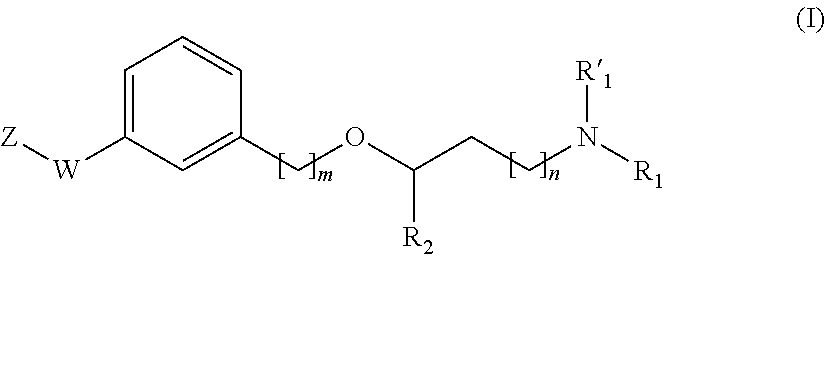Propanamine derivatives for treating pain and pain related conditions
a technology of derivatives and propanamines, applied in the field of compounded drugs, can solve the problems of unrelief for patients, significant productivity loss and socio-economic burden, and poor safety ratio, and achieve the effect of improving the safety ratio of patients
- Summary
- Abstract
- Description
- Claims
- Application Information
AI Technical Summary
Benefits of technology
Problems solved by technology
Method used
Image
Examples
examples
[0327]In the next preparation examples the preparation of both intermediates compounds as well as compounds according to the invention are disclosed.
[0328]The following abbreviations are used in the examples:[0329]ACN: Acetonitrile[0330]Anh: Anhydrous[0331]Aq: Aqueous[0332]Conc: Concentrated[0333]CH: Cyclohexane[0334]DCM: Dichloromethane[0335]DCE: 1,2-Dichloroethane[0336]DEA: Diethylamine[0337]DIAD: Diisopropyl azodicarboxylate[0338]DIBAL: Diisobutylaluminium hydride[0339]DIPEA: N,N-Diisopropylethylamine[0340]DMA: N,N-Dimethylacetamide[0341]DMSO: Dimethylsulfoxide[0342]EtOAc: Ethyl acetate[0343]EtOH: Ethanol[0344]Ex: Example[0345]h: Hour / s[0346]HATU: 2-(7-Aza-1H-benzotriazole-1-yl)-1,1,3,3-tetramethyluronium[0347]Hex: Hexane[0348]HPLC: High-performance liquid chromatography[0349]INT: Intermediate[0350]IPA: Isopropanol[0351]MeOH: Methanol[0352]MS: Mass spectrometry[0353]Min: Minutes[0354]PPh3: Triphenylphosphine[0355]Quant: Quantitative[0356]Ret: Retention[0357]rt: Room temperature[0...
preparation examples
Example 1: 3-(3-((Benzyl(ethyl)amino)methyl)phenoxy)-N-methyl-3-(thiophen-2-yl)propan-1-amine
[0369]
a) 3-(3-Chloro-1-(thiophen-2-yl)propoxy)benzaldehyde
[0370]To a solution of 3-chloro-1-(thiophen-2-yl)propan-1-ol (1.00 g, 5.66 mmol) in THF (10 mL) 3-hydroxybenzaldehyde (0.69 g, 5.66 mmol) and PPh3 (1.63 g, 6.23 mmol) were added. The mixture was cooled to 0° C. and then DIAD (1.26 g, 6.23 mmol) was added dropwise. The reaction mixture was warmed slowly at rt and stirred for 16 h. The solvent was removed under vacuum and the residue was purified by flash chromatography, silica gel, gradient CH to 100% EtOAc to afford the title compound (700 mg, 44% yield). HPLC (Method B): Ret, 5.56 min; ESI+-MS m / z, 281.2 (M+H).
b) N-benzyl-N-(3-(3-chloro-1-(thiophen-2-yl)propoxy)benzyl)ethanamine
[0371]To a solution of the compound obtained in step a (80 mg, 0.28 mmol) in DCE (2 mL), N-benzylethanamine (58 mg, 0.42 mmol) and NaBH(OAc)3 (121 mg, 0.57 mmol) were added and the mixture was stirred at rt fo...
example 7
hylamino)-1-(thiophen-2-yl)propoxy)-N-(pyridin-2-ylmethyl)benzamide
[0375]
a) Methyl 3-(3-chloro-1-(thiophen-2-yl)propoxy)benzoate
[0376]3-Chloro-1-(thiophen-2-yl)propan-1-ol was treated with methyl 3-hydroxybenzoate in the conditions used in EX 1 step a, to afford the title compound (34% yield). HPLC (Method B): Ret, 5.80 min; ESI−-MS m / z, 309.1 (M−H).
b) 3-(3-Chloro-1-(thiophen-2-yl)propoxy)benzoic acid
[0377]To a solution of the compound obtained in step a (360 mg, 1.15 mmol) in a (1:1) mixture of THF and water (12 mL), LiOH (166 mg, 6.95 mmol) was added and the mixture was heated at 100° C. for 1 h. The reaction mixture was cooled at rt, citric acid solution was added until pH=5 and extracted with DCM to afford the title compound that was used in the next step without further purification (quant yield). HPLC (Method B): Ret, 5.14 min; ESI+-MS m / z, 319.0 (M+Na).
c) 3-(3-Chloro-1-(thiophen-2-yl)propoxy)-N-(pyridin-2-ylmethyl)benzamide
[0378]To a solution of the compound obtained in step ...
PUM
| Property | Measurement | Unit |
|---|---|---|
| temperature | aaaaa | aaaaa |
| temperature | aaaaa | aaaaa |
| temperature | aaaaa | aaaaa |
Abstract
Description
Claims
Application Information
 Login to View More
Login to View More - R&D
- Intellectual Property
- Life Sciences
- Materials
- Tech Scout
- Unparalleled Data Quality
- Higher Quality Content
- 60% Fewer Hallucinations
Browse by: Latest US Patents, China's latest patents, Technical Efficacy Thesaurus, Application Domain, Technology Topic, Popular Technical Reports.
© 2025 PatSnap. All rights reserved.Legal|Privacy policy|Modern Slavery Act Transparency Statement|Sitemap|About US| Contact US: help@patsnap.com



